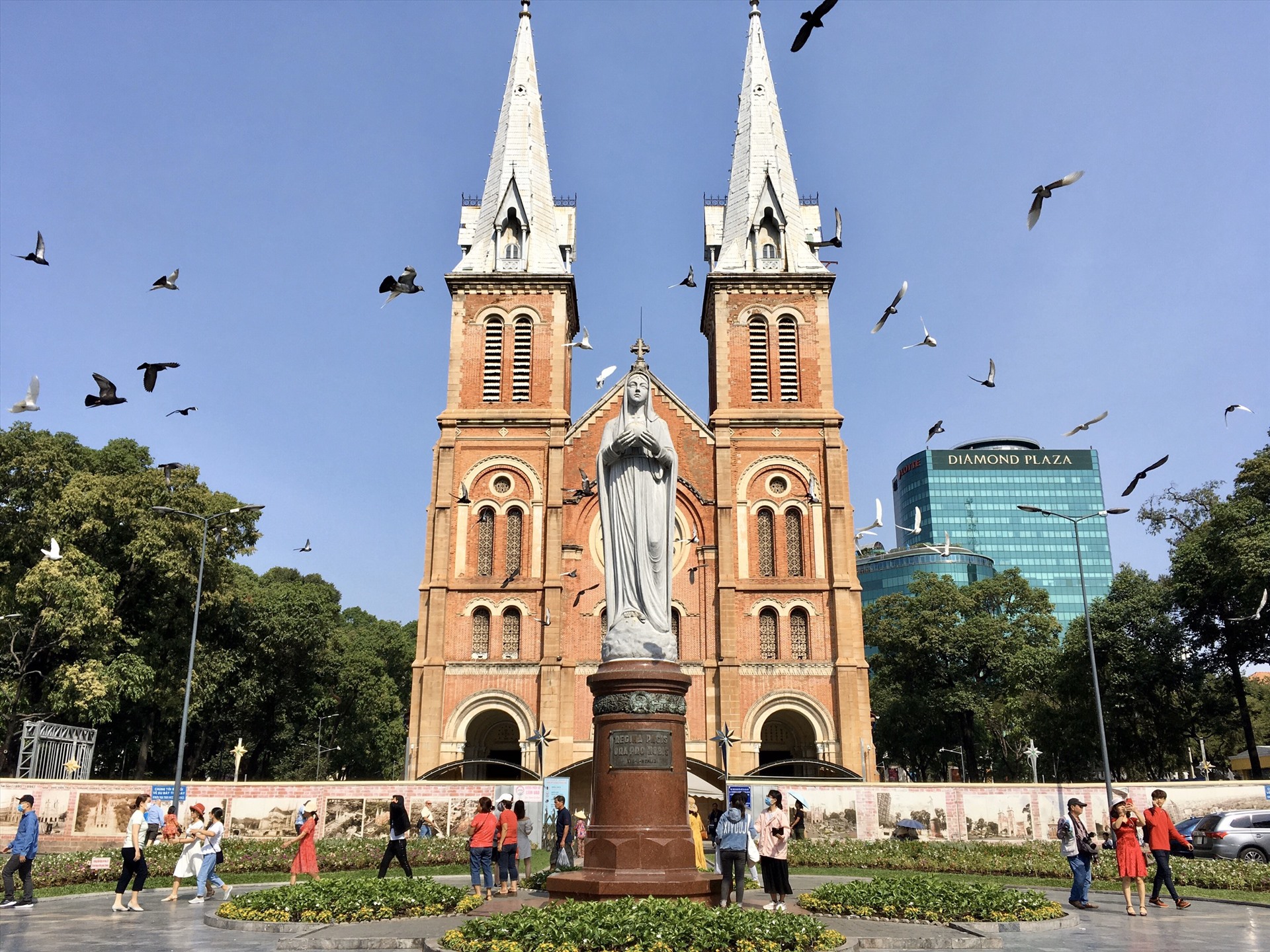Top 10 Must-Try Northern Vietnamese Dishes 2025
Date: 2025.10.08
Introduction to Northern Vietnamese Cuisine
Northern Vietnam, serving as the cultural cradle of the nation, has forged and created a distinctive culinary identity over thousands of years of history. Northern Vietnamese cuisine is not merely a way of cooking food, but also tells the story of lifestyle, behavior, and the noble humanistic values of Vietnamese people.
Northern Vietnamese cuisine is deeply characterized by its standardized nature with balanced flavors – mild, light, and gentle, yet featuring vibrant colors and sophistication in every detail. Each dish is carefully refined and has become a standard that is not easily changed, reflecting the character of a long-standing culture.
In 2025, as culinary tourism continues to develop, exploring Northern Vietnamese specialty dishes is not only a taste experience but also a journey to understand the culture, history, and people of this region. Let’s join Help All in reviewing 10 must-try dishes when visiting Northern Vietnam.
1. Hanoi Pho
Hanoi Pho is considered the symbol of Vietnamese cuisine, especially in the North. This dish originated in the early 20th century, stemming from the combination of Vietnamese and French culinary cultures. The special characteristic of Hanoi Pho is its clear broth, simmered from beef bones for many hours, offering a light yet rich flavor.
Traditional Hanoi Pho usually has two main types: pho tai (rare beef) and pho chin (well-done beef). The rice noodles must be soft and chewy, neither too big nor too small. The beef is sliced thin and fresh. Accompanying seasonings include finely chopped scallions, cilantro, and a bit of black pepper.
To properly enjoy pho, you should eat it while the broth is still hot, and shouldn’t add too many herbs or seasonings to preserve the characteristic light flavor. A delicious bowl of Hanoi Pho must have harmony between the broth, rice noodles, beef, and seasonings.
Some good Pho restaurants:
– Pho Vy Nam
📍119 Tam Trinh Street, Mai Dong Ward, Hanoi
🌐 dayphovynam.com
– Pho Gia Truyen Bat Dan
📍 49 Bat Dan Street, Cua Dong Ward, Hanoi
– Pho Dau
📍 288 M1, 288J1 Nam Ky Khoi Nghia Street, Xuan Hoa Ward, Ho Chi Minh City
– Pho Cao Van
📍 25 Mac Dinh Chi Street, Tan Dinh Ward, Ho Chi Minh City
🌐 foody.vn/ho-chi-minh/pho-cao-van

2. Bun Cha
Bun cha is considered a specialty of Hanoi, famous worldwide after former US President Barack Obama enjoyed it at a bun cha restaurant in Hanoi’s Old Quarter in 2016. This dish includes fresh rice noodles, grilled pork patties, and characteristic sweet and sour fish sauce.
The pork patties in bun cha consist of two types: cha cua (round patties) and cha thit (pork strips). Cha cua is made from ground pork belly, shaped into round balls and grilled over charcoal. Cha thit is made from sliced pork belly, marinated with spices and grilled until golden. The dipping fish sauce has a balanced sweet and sour taste, often with added papaya and pickled vegetables.
The proper way to enjoy bun cha is to put the noodles in the fish sauce bowl, accompanied by fresh herbs like lettuce, Vietnamese mint, basil, and perilla. This dish brings the rich flavor of charcoal and harmony between ingredients, creating an unforgettable culinary experience.
Some good Bun Cha restaurants:
– Bun Cha Dac Kim
📍 1 Hang Manh Street, Hang Gai Ward, Hanoi
🌐 bunchahangmanh.vn
– Bun Cha Huong Lien
📍 24 Le Van Huu Street, Phan Chu Trinh Ward, Hanoi
🌐 facebook.com/bunchahuonglienobama
– Bun Cha Ho Guom
📍 128C-130 Nguyen Dinh Chieu Street, Xuan Hoa Ward, Ho Chi Minh City
🌐 bunchahoguom.vn
– Bun Cha Anh Hong
📍 117 Ly Chinh Thang Street, Ban Co Ward, Ho Chi Minh City
🌐 bunchaanhhong.com
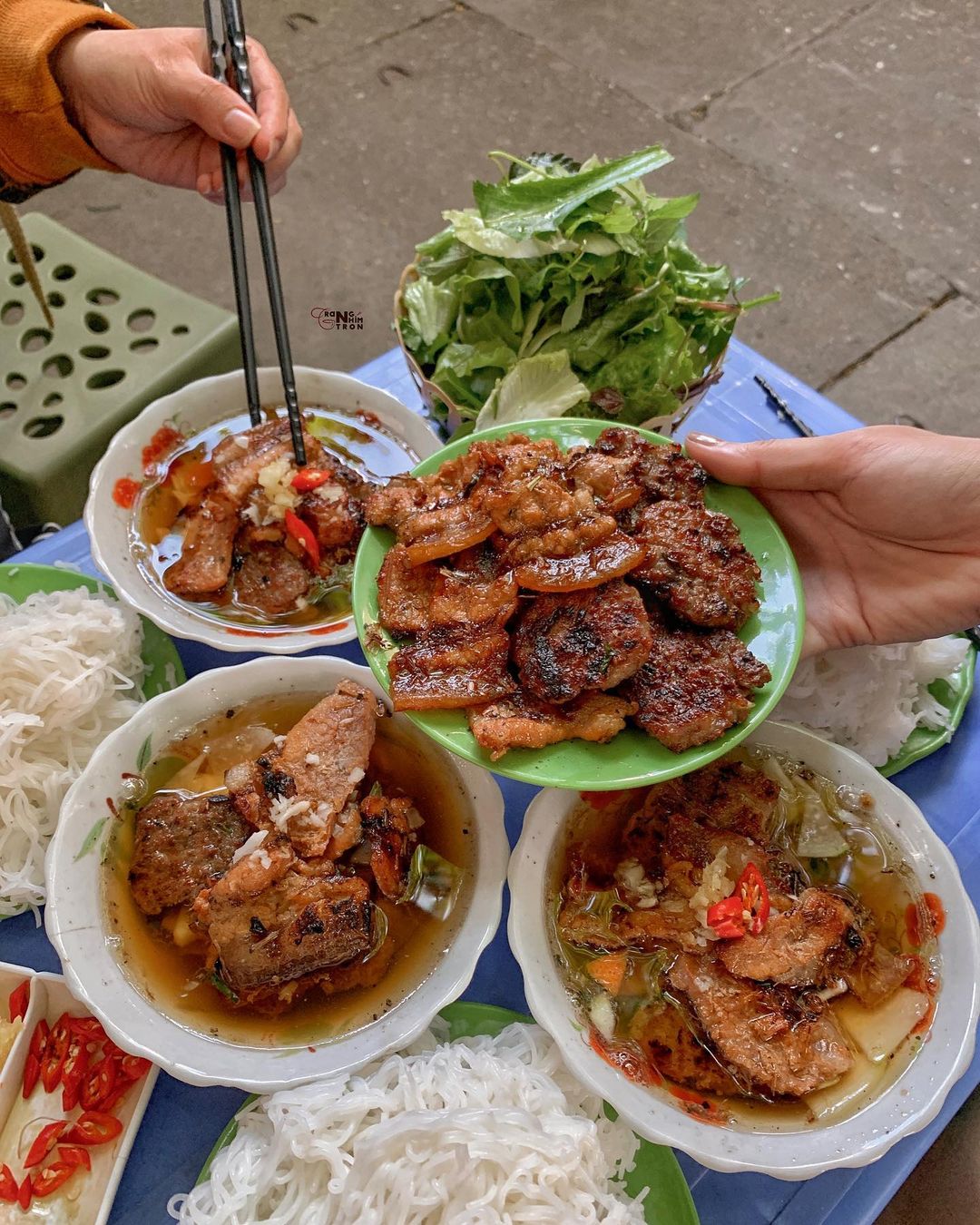
3. Thanh Tri Rice Paper Rolls
Thanh Tri Village (now part of Linh Nam ward, Hoang Mai district, Hanoi) has been famous for making rice paper rolls for hundreds of years. Rice paper rolls are made from diluted rice flour batter, spread thin on a wide pan, creating sheets as thin as paper.
The filling consists of ground pork, shiitake mushrooms, and finely chopped onions, stir-fried until cooked and seasoned to taste. Rice paper rolls are served with Vietnamese pork roll, crab cake, fresh pork sausage, herbs, and sweet and sour fish sauce. The special feature of Thanh Tri rice paper rolls is that the paper must be thin, soft, and not tear when rolling.
The art of making rice paper rolls requires skill and experience. The cook must know how to control the heat, batter consistency, and timing of spreading the paper to create perfect sheets. Thanh Tri rice paper rolls are not only a dish but also a culinary art recognized by UNESCO.
Some good Thanh Tri Rice Paper Roll restaurants:
– Banh Cuon Ba Hoanh
📍 66 To Hien Thanh Street, Cua Nam Ward, Hanoi
– Banh Cuon Thanh Tri Co Lan
📍 30 Thanh Dam Street, Thanh Tri Ward, Hanoi
– Banh Cuon Thanh Tri Kim Lien
📍 14/3D Chu Manh Trinh Street, Sai Gon Ward, Ho Chi Minh City
🌐 foody.vn/ho-chi-minh/banh-cuon-thanh-tri-kim-lien
– Banh Cuon Ba Hanh
📍 74 Le Thi Rieng Street, Phu Thuan Ward, Ho Chi Minh City
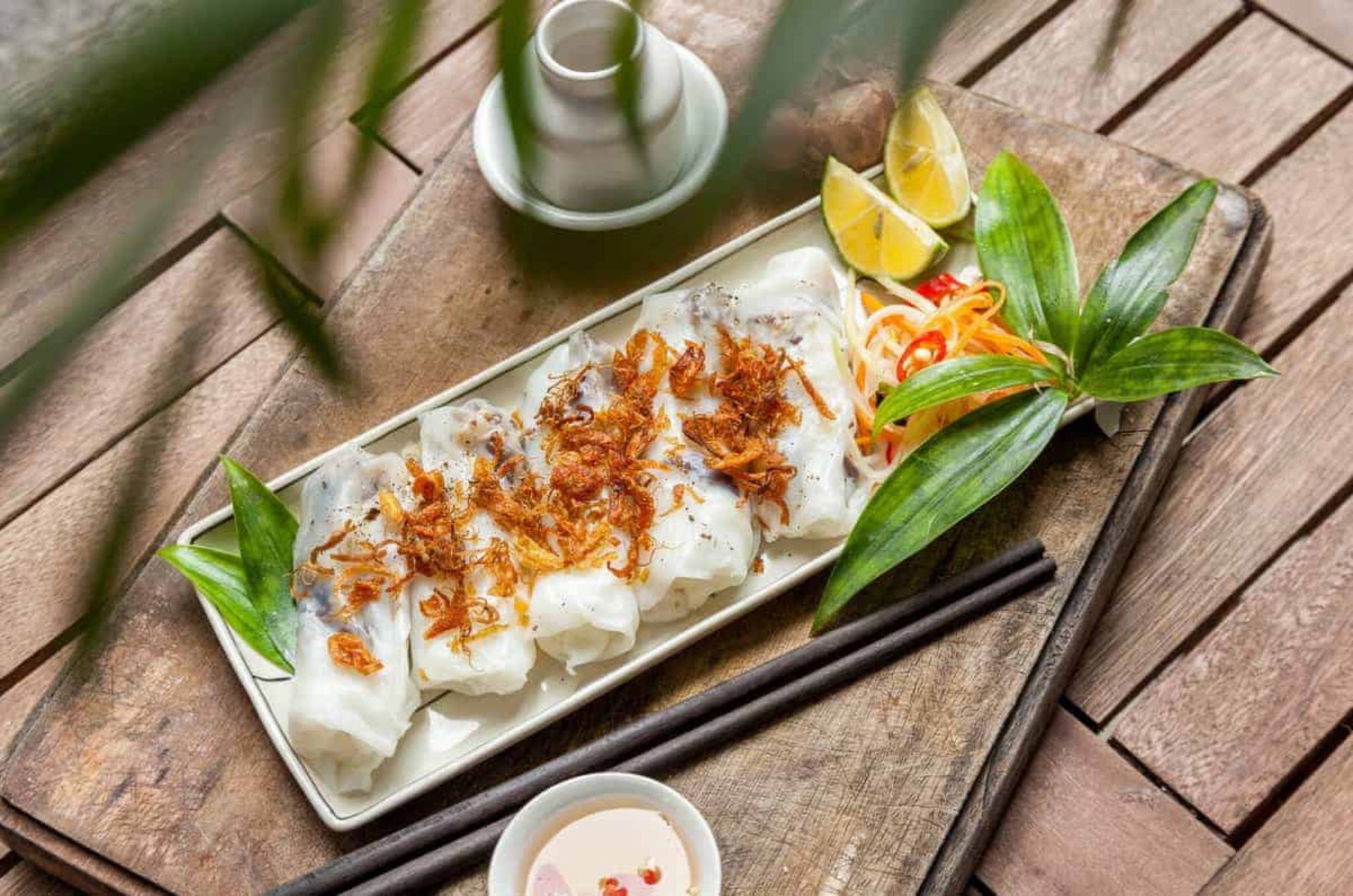
4. Cha Ca La Vong
Cha Ca La Vong is a dish with a long history, appearing since French colonial times and has become a Hanoi specialty for over 150 years. This dish was created by the Doan family on Cha Ca Street (now Cha Ca La Vong Street), and quickly became famous throughout all 63 provinces of the country.
The main ingredient of Cha Ca La Vong is fresh river cobbler (catfish), deboned thoroughly, cut into thick pieces, and marinated with special spices like turmeric, galangal, and fermented shrimp paste. The fish is first grilled over charcoal, then brought to the table and cooked in a hot cast iron pan with oil, fragrant with scallions and dill.
Cha Ca La Vong is enjoyed with fresh rice noodles, herbs like dill, Vietnamese mint, basil, roasted peanuts, and rich fermented shrimp sauce. The distinctive fragrance of dill and the fatty taste of grilled fish create an unforgettable dish. This unique way of eating makes Cha Ca La Vong an unmissable culinary experience.
Some good Cha Ca La Vong restaurants:
– Cha Ca Anh Vu
📍 17 Cha Ca Street, Hang Buom Ward, Hanoi
– Cha Ca HE
📍 8/12 Tran Quy Kien Street, Cau Giay Ward, Hanoi
– Cha Ca La Vong
📍 7 Ho Xuan Huong Street, Xuan Hoa Ward, Ho Chi Minh City
– Cha Ca De Vuong
📍 35 Truong Son Street, Ward 4, Ho Chi Minh City
🌐 chacadevuong.com

5. Com Lang Vong (Green Rice Flakes)
Lang Vong Village (now part of Dong Ngac ward, Bac Tu Liem district, Hanoi) has been making green rice flakes for hundreds of years. Com is made from young rice, harvested at the right time when the rice grains are not yet mature, still tender and naturally green.
The process of making com is quite complex: rice is roasted in a large pan over low heat, then pounded with a stone mortar to remove the husks, finally sifted to get the fresh green rice flakes. Good com must have a natural green color, tender grains, thin skin, and the characteristic fragrance of young rice.
Com can be eaten directly or used to make dishes like com cakes, com sweet soup, or chewy com. The traditional way of enjoying it is to wrap com in young banana leaves and eat with ripe bananas. The natural sweetness of com blends with the gentle fragrance of banana leaves, creating a refined culinary experience.
Some good Com Lang Vong places:
– Com Lang Vong Ba Hoan
📍 36 Alley 63, Xuan Thuy Street, Cau Giay Ward, Hanoi
🌐 comvonghanoi.com
– Com Thu Hue
📍 16 Me Tri Thuong Street, Tu Liem Ward, Hanoi
🌐 commetri.com
– Hanoi Food Store Tien Hue
📍 68C Nguyen Van Troi Street, Ward 7, Ho Chi Minh City
🌐 www.tienhue.com

6. Bun Oc (Snail Noodle Soup)
Bun oc is a dish with rich broth made from pork bones, shrimp, crab, and especially from snails. There are various types of bun oc such as cold bun oc, sour bun oc, and bun rieu cua oc (crab and snail soup), each with its own distinct flavor.
The main ingredient of bun oc is fresh snails like river snails, fingernail clams, and spiral snails, washed clean and boiled until cooked. The broth is cooked from pork bones, shrimp, crab, tomatoes, and especially the snail cooking water to create the distinctive flavor. Bun oc usually includes additional ingredients like field crab, dried shrimp, fish cake, and pork sausage.
Bun oc is served with herbs like Vietnamese mint, sawleaf herb, perilla, lettuce, and fermented shrimp dipping sauce. The rich flavor of the broth combined with the natural sweetness of snails and herbs creates an attractive dish. Bun oc is not only delicious but also very nutritious.
Some good Bun Oc restaurants:
– Bun Oc Co Hue
📍 43 Nguyen Sieu Street, Hang Buom Ward, Hanoi
– Lau Oc Ba Luong
📍 34 and 64 Alley 189, Khuong Thuong Ward, Hanoi
– Bun Oc Suon Co Sau
📍 457 Hai Ba Trung Street, Xuan Hoa Ward, Ho Chi Minh City
🌐 facebook.com/bunocsuoncosau

7. Nem Cua Be (Crab Spring Rolls)
Nem cua be is a specialty dish from coastal areas of Northern Vietnam like Hai Phong and Quang Ninh. This dish is made from fresh field crabs with sweet meat and high nutrition. There are two main types: grilled crab spring rolls and fried crab spring rolls.
Field crabs are carefully selected, and the meat and crab roe are mixed with ground pork belly, onions, shiitake mushrooms, eggs, and seasonings. This mixture is wrapped in thin rice paper and grilled over charcoal or fried until crispy. When cooked, crab spring rolls have a beautiful golden color and enticing aroma.
Nem cua be is served with fresh noodles, herbs like lettuce, Vietnamese mint, basil, and sweet and sour fish sauce. The natural sweetness of crab combined with the fragrance of herbs creates a special dish. Nem cua be is not only delicious but also carries the rich flavor of the sea.
Some good Nem Cua Be restaurants:
– Quan Nga Nem Cua Be
📍 92 Tran Nhat Duat Street, Cau Dat Ward, Hai Phong
– Bun Cha Binh Minh – Nem Cua Be
📍 23 Bat Su Street, Hang Bo Ward, Hanoi
– Quan Nem Restaurant
📍 15E Nguyen Thi Minh Khai, Sai Gon Ward, Ho Chi Minh City

8. Banh Tom Ho Tay (West Lake Shrimp Cakes)
Banh Tom Ho Tay is one of the most famous street food dishes in Hanoi. This dish originated from craft villages around West Lake, where fresh shrimp are abundant. Shrimp cakes are made from diluted rice flour batter mixed with fresh shrimp, then fried until golden and crispy.
The main ingredient of banh tom is fresh prawns (freshwater prawns), washed clean and peeled but with heads kept intact. The batter is made from rice flour, potato starch, eggs, and water. The mixing ratio must be correct so the cakes are crispy but not hard. Shrimp cakes are fried in hot oil over medium heat so they cook evenly and have a beautiful golden color.
Banh Tom Ho Tay is served with herbs like lettuce, Vietnamese mint, basil, cucumber, and sweet and sour fish sauce. The crispiness of the cake, the sweetness of fresh shrimp combined with herbs creates an attractive snack. Shrimp cakes are usually enjoyed in the afternoon or evening, perfect for gatherings with friends.
Some good Banh Tom Ho Tay restaurants:
– Banh Tom Ho Tay Restaurant
📍 Thanh Nien Street, Yen Phu Ward, Hanoi
🌐 banhtomhotay.com
– Banh Tom Ba Loc
📍 No. 6, Alley 80 Pham Ngoc Thach Street, Phuong Mai Ward, Hanoi
🌐 banhtombaloc.com
– Quan Ngon 138
📍 138 Nam Ky Khoi Nghia Street, Sai Gon Ward, Ho Chi Minh City
🌐 facebook.com/quanngon138.fan
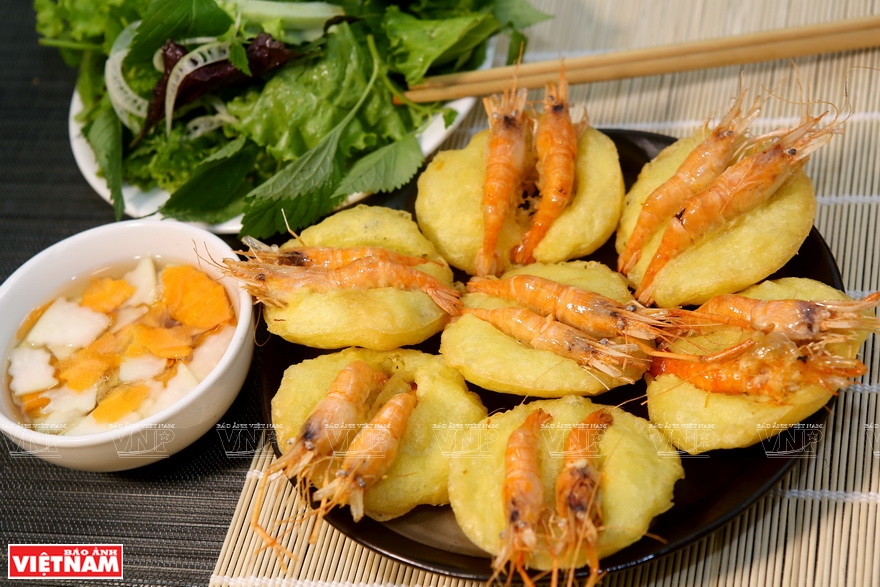
9. Xoi Xeo (Yellow Sticky Rice)
Xoi xeo is a traditional breakfast dish of Hanoi people, with a characteristic yellow color from fresh turmeric. The name “xoi xeo” may come from the fact that the sticky rice is stir-fried (xeo) in a pan to create stickiness and beautiful yellow color. This dish is simple but very attractive and nutritious.
The main ingredient of xoi xeo is white glutinous rice, soaked overnight and then cooked. During cooking, fresh turmeric is added to create the natural yellow color. After cooking, the sticky rice is stir-fried in a pan with a little lard to create stickiness and aroma. Xoi xeo often includes mung beans with curry powder for added flavor.
Xoi xeo is served with Vietnamese pork roll, crab cake, pate, boiled quail eggs, pickled vegetables, and chili sauce. The traditional way of eating is to wrap the sticky rice in banana leaves and eat with bamboo spoons. The chewy sweetness of sticky rice, the richness of curry mung beans combined with various sausages create a nutritious and delicious breakfast.
Some good Xoi Xeo restaurants:
– Quan Xoi Cat Lam
📍 24B Duong Thanh Street, Cua Dong Ward, Hanoi
– Xoi Xeo Lap Thuy
📍 11 Vong Duc Street, Hang Bai Ward, Hanoi
– Xoi Xeo Ba 3 Beo
📍 103 Tran Trong Cung Street, Tan Thuan Dong Ward, Ho Chi Minh City
– Xoi La Sen
📍 35 Ngo Thi Thu Minh Street, Ward 3, Ho Chi Minh City

10. Ca Kho Lang Vu Dai (Vu Dai Village Braised Fish)
Ca kho lang Vu Dai is a famous specialty of Ha Nam province, closely associated with the Red River delta region and reminiscent of the rural setting in the work “Chi Pheo” by writer Nam Cao. This braised fish is made according to traditional family recipes passed down for hundreds of years, gradually becoming an indispensable culinary “brand” for Tet (Vietnamese New Year).
The main ingredient is natural black carp, selected for thick pieces with firm flesh, braised continuously for 12 to 16 hours in clay pots. The seasonings are completely natural, including good fish sauce, palm sugar, pepper, ginger, galangal, and secret traditional ingredients, with no preservatives.
The special characteristic of Vu Dai braised fish is its rich flavor, fragrant aroma, with firm fish meat that is not dry, fatty but not greasy. Each pot of fish represents the dedication and meticulousness of the village craft makers, especially during the pre-Tet period when the entire village is red with fire all night to serve domestic and export demands.
Some good Ca Kho Lang Vu Dai restaurants:
– Vu Dai Village Braised Fish Store – Hoang Tho
📍 Hamlet 11, Ly Nhan Commuce, Ha Nam City
🌐 cakhohoangtho.vn
– Ca Kho Lang Vu Dai – Tran Luan
📍 Hamlet 2, Ly Nhan Commune, Ha Nam City
🌐 cakhotranluan.com
– Vu Dai Village Restaurant
📍 84 Song Hanh Street, An Phu Ward, Ho Chi Minh City
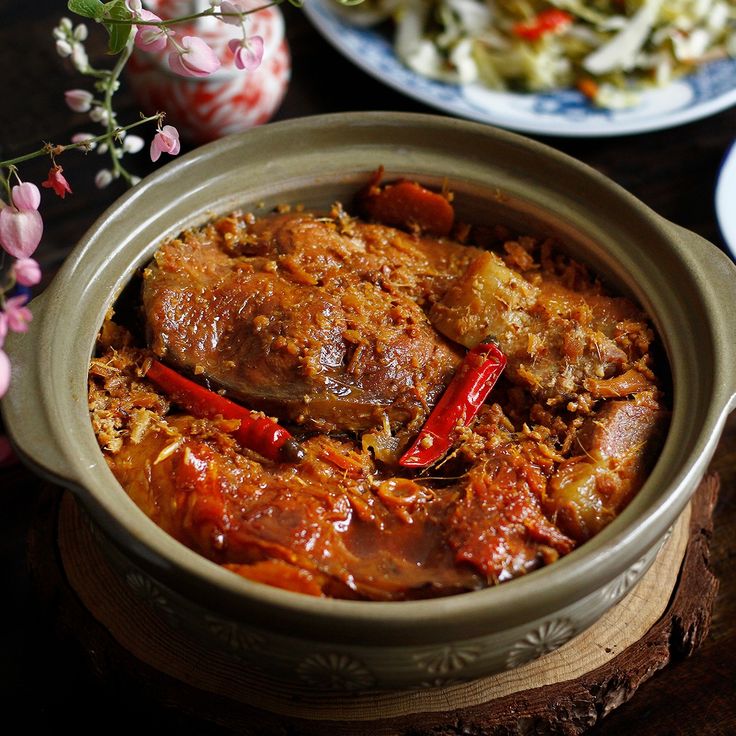
Conclusion
After exploring these 10 distinctive Northern Vietnamese dishes, we can see that the cuisine here is truly a priceless treasure. The most precious aspect of Northern Vietnamese cuisine is its persistence in preserving traditional flavors. In modern times, when many dishes are changed to suit popular tastes, Northern Vietnamese dishes still maintain their original character, from preparation methods to ways of enjoying them.
For first-time visitors to Northern Vietnam, don’t just stop at eating your fill. Take time to feel the atmosphere of the old streets, listen to the street vendors’ calls in the early morning, and chat with the craftspeople who have been devoted to their trade all their lives. Because in essence, Northern Vietnamese cuisine is not just food, but an entire way of life, a philosophy about simplicity yet sophistication, rustic yet profound.
Let these flavors become a bridge between past and present, between tradition and modernity, helping us appreciate more the precious cultural values that our ancestors have left behind.




